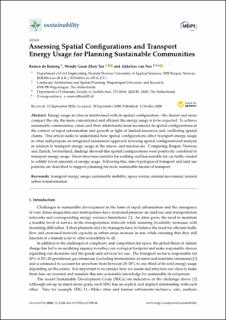| dc.contributor.author | de Koning, Remco Elric | |
| dc.contributor.author | Tan, Wendy | |
| dc.contributor.author | van Nes, Akkelies | |
| dc.date.accessioned | 2020-10-05T08:43:03Z | |
| dc.date.available | 2020-10-05T08:43:03Z | |
| dc.date.created | 2020-10-02T17:38:25Z | |
| dc.date.issued | 2020 | |
| dc.identifier.citation | Koning, R. de, Tan, W. G. Z., & van Nes, A. (2020). Assessing Spatial Configurations and Transport Energy Usage for Planning Sustainable Communities. Sustainability, 12(19), 8146. | en_US |
| dc.identifier.issn | 2071-1050 | |
| dc.identifier.uri | https://hdl.handle.net/11250/2681071 | |
| dc.description.abstract | Energy usage in cities is intertwined with its spatial configuration—the denser and more compact the city, the more concentrated and efficient the energy usage is to be expected. To achieve sustainable communities, cities (and their inhabitants) must reconsider its spatial configurations in the context of rapid urbanisation and growth in light of limited resources and conflicting spatial claims. This article seeks to understand how spatial configurations affect transport energy usage in cities and propose an integrated assessment approach factoring spatial configurational analysis in relation to transport energy usage at the micro- and macroscale. Comparing Bergen, Norway, and Zürich, Switzerland, findings showed that spatial configurations were positively correlated to transport energy usage. Street structures suitable for walking and less suitable for car traffic tended to exhibit lower amounts of energy usage. Following this, nine typologies of transport and land use patterns are described to support planning for more sustainable means of transport. | en_US |
| dc.language.iso | eng | en_US |
| dc.publisher | MDPI | en_US |
| dc.rights | Navngivelse 4.0 Internasjonal | * |
| dc.rights.uri | http://creativecommons.org/licenses/by/4.0/deed.no | * |
| dc.subject | transport energy usage | en_US |
| dc.subject | sustainable mobility | en_US |
| dc.subject | space syntax | en_US |
| dc.subject | natural movement | en_US |
| dc.subject | natural urban transformation | en_US |
| dc.title | Assessing Spatial Configurations and Transport Energy Usage for Planning Sustainable Communities | en_US |
| dc.type | Peer reviewed | en_US |
| dc.type | Journal article | en_US |
| dc.description.version | publishedVersion | en_US |
| dc.rights.holder | © 2020 by the authors | en_US |
| dc.subject.nsi | VDP::Samfunnsvitenskap: 200::Urbanisme og fysisk planlegging: 230 | en_US |
| dc.source.volume | 12 | en_US |
| dc.source.journal | Sustainability | en_US |
| dc.source.issue | 19 | en_US |
| dc.identifier.doi | 10.3390/su12198146 | |
| dc.identifier.cristin | 1836690 | |
| cristin.ispublished | true | |
| cristin.fulltext | original | |
| cristin.qualitycode | 1 | |

